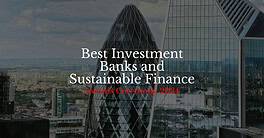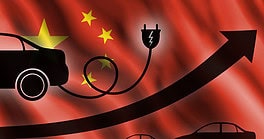Despite attempts to reach net-zero, companies are still struggling to hit their goals.

Since the Paris Agreement entered into force in November 2016, momentum in energy-transition financing has been slow. Despite numerous net-zero commitments and the ongoing growth of the sustainable-investment industry, energy-transition investments remain less than 1% of the $130 trillion available for sustainable financing, according to Citibank research.
The need to mobilize capital for this transition was in stark focus at the 27th Conference of the Parties to the UN Framework Convention on Climate Change (COP27) in Egypt. Among the delegates was Karen Fang, managing director and global head of Sustainable Finance at Bank of America (BofA), whose key takeaway was the high engagement level of the private sector.
“I think the extent of that commitment had previously been underestimated,” she says. “The private sector is certainly a willing and vital participant at the table.”
A passionate climate advocate, Fang says the question is how the private sector can engage to scale capital to what was calculated in 2021 by the World Resources Institute, a US-based think tank, to be a $3 trillion to $5 trillion annual bill for funding climate change measures—with $1 trillion per year needed in emerging markets alone.
Reflecting on some of the climate commitments made to date as part of the wider COP agenda, Sasha Cook, head of Investment Banking for the Western Cape and sustainable finance executive at Standard Bank in South Africa, believes those commitments should really be considered the bare minimum.
“What came out of COP27 was the need for action and innovation, and for different thinking when looking at how the energy transition is going to be financed—whether that’s blended finance, including debt for environment swaps, or scaling up very early-stage initiatives,” Cook says.
Standard Bank’s climate policy includes a commitment to mobilize 250 to 300 billion South African rand (about $14.4 to $17.3 billion) in sustainable finance by the end of 2026, with a specific commitment of 50 billion rand in climate financing over the next three years, and to underwrite an additional 15 billion for renewable-energy power plant financing by the end of 2024.
Standard’s recent funding of the Scatec project in South Africa’s is one such example. With a project cost of 18 billion rand, this sizeable solar project brings an additional 540 megawatts of clean energy to the grid in South Africa. Separately, SOLA Group’s two solar photovoltaic projects will supply electricity to five facilities of African mining company Tronox Mineral Sands in the Western Cape and KwaZulu-Natal. And in November, the bank financed a wind-powered renewable-energy plant for EDF Renewables.
In addition to direct project-financing support, the bank is now engaging daily with corporate clients’ sustainability plans—a key focus of which is emissions reduction. “We have put in place sustainability linked facilities with several clients across a spectrum of sectors, whereby we embed certain sustainability KPIs—and in this instance there is a real focus on renewable energy or carbon emissions reduction—into the loan or the bond itself,” Cook explains. “The client obtains a margin or a pricing benefit because we set targets for those specific KPIs over the tenor of the facility.”
For small and midsize enterprises (SMEs) looking to engage in the energy transition, the bank’s new PowerPulse digital platform enables clients to engage with suppliers that can support them with sustainable energy solutions. “[This] enables clients to engage with accredited energy-solution providers and ultimately ensures they obtain the lowest-cost sustainable-energy solution,” says Cook.
The role of banks in absorbing risk among SMEs is a key focus area for HSBC, whose global head of Commercial Banking Sustainability, Natalie Blyth, says that while much of the dialogue on energy transition focuses on the actions of large firms and policymakers, the role that smaller enterprises have to play is vital to achieving net-zero targets. “SMEs make up 90% of global supply chains, which themselves account for nearly 80% of total carbon emissions,” Blyth explains. “Bank support is critical to help SMEs on their transition journey, including dedicated SME funds that are available to use for green activities.”
Carbon credits are another area generating excitement, with Standard in the early stages of setting up a carbon trading desk. Rabobank, for example, a world leader in agricultural finance, goes beyond financing emissions reductions with a carbon credit program that supports farmers in actually removing carbon from the atmosphere via regenerative practices.
A New Strategy
An effective strategy for the transition should focus on three main areas, according to BofA’s Fang: expanding use of mature technologies (such as wind and solar); accelerating development of emerging technologies (such as carbon capture and sequestration, electric vehicles, green hydrogen, long-duration energy storage and biofuels) by reducing the “green premium”; and delivering for emerging markets in collaboration with governments, multilateral development banks and development finance institutions (DFIs) by leveraging blended-finance solutions.
Historically BofA’s investments have contributed to the development of approximately 16% of total installed renewable wind and solar energy capacity in the US. In Africa, the bank has supported CrossBoundary Energy (CBE), a specialist in commercial and industrial renewable-energy projects, in its plans to rapidly scale investment for such businesses across the region. CBE is currently delivering a $230 million portfolio of projects across 14 African countries for more than 30 corporate customers, including Unilever, Diageo, Rio Tinto, Heineken and AB InBev.
Regional Challenges
In Africa, the need for development combined with a significant wave of oil and gas discoveries create a counterpoint to sustainable energy efforts.
“It’s important to have an Africa lens when we look at some of the Paris Agreement goals—or the goals that have been established by the developed world,” Standard Bank’s Cook explains. “Improving living conditions and facilitating economic growth in some of these developing nations, and investment in long-term sustainable infrastructure, are as important as climate.”
Further, given the fiscal stress being felt by a number of African countries, a reliance on foreign exchange, or dollar-based financing, presents further challenges to building up infrastructure. Given a lack of appetite for additional debt, support from developed nations, DFIs and the blended-finance concept are really required to meet these goals. “Given the challenges many African countries face in terms of fiscal debt,” she says, “there is a need for some of this funding to be more heavily weighted towards the donor or the grant side of the financing spectrum.”
Emerging Markets
Another example of how the public and private sectors in developed countries are collaborating to deliver more climate finance capital in emerging markets can be found in Indonesia, where the government is pursuing a national effort under a Just Energy Transition Partnership (JETP) to accelerate the phasing out of fossil-fueled power plants and the ramping up of renewable energy, alongside investment in transition-aligned jobs and industries of the future. Contributions to the Indonesia JETP to be mobilized over the next three to five years include $10 billion in public sector pledges and $10 billion in private investment from an initial set of private financial institutions, including BofA, Deutsche Bank, HSBC, Macquarie, MUFG, and Standard Chartered.
Elsewhere, in the Caribbean and in Central and South America, BofA has worked alongside a multilateral development bank to support InterEnergy Group via a green loan to help develop renewable energy and clean transportation infrastructure projects. It is in emerging technologies such as green hydrogen, carbon capture and sequestration, long-duration energy storage and biofuels like sustainable aviation fuel, that Fang sees a “huge leapfrogging opportunity” for emerging markets.
“Governments will need to continue to play a key catalyzing role,” she says, “through grants, concessionary capital and incentives in order to make the projects bankable by the private sector, driving down cost and speeding up the supply-demand flywheel.” The US and developed markets have to take the lead, she adds, as in the US, where the Inflation Reduction Act of 2022 offers up $370 billion worth of incentives for sustainability technologies.
“We’re all aligned on this to help drive down the green premium on these technologies such that they are on a par with fossil fuel technology,” Fang explains. “Once that equation is reached, I believe penetration of these new technologies will become more prolific. I think we can divide and conquer here.”



